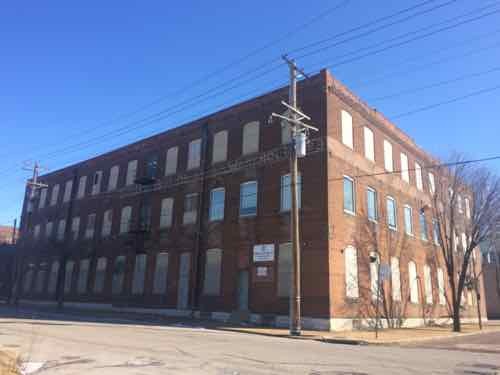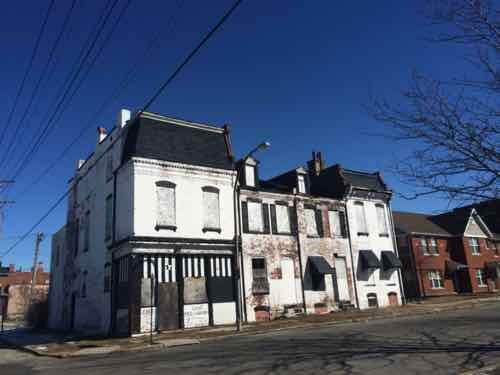Potential On 22nd Street Across From Possible National Geospatial-Intelligence Agency Location
Let’s assume the National Geospatial-Intelligence Agency selects the 100-acre site in North St. Louis, over three others in the region, for its new campus, see Urban Renewal Officially Ended In 1974, Still Alive In St. Louis. Will this help or hinder the redevelopment of the surrounding blocks? The planned clearance of 100 acres will leave a one block wide strip across 22nd, to the East. To the South is Cass Ave and the former Pruitt-Igoe site, to the West is the excessively-wide Jefferson Ave. To the North will be the backs of properties facing St. Louis Ave.
Thus the biggest opportunity for positive impact on exiting development is East of 22nd Street, two corners stand out:


Neither of these corners are architectural gems, but their age is a nice contrast to already built infill and the secure fortress of what the National Geospatial-Intelligence Agency would build. The old cast iron storefront at Madison might house a coffeehouse/cafe — a place for the new employment base to walk to for lunch. This could be a chance for an existing resident to become an entrepreneur, hiring others from the area.
I don’t know if the National Geospatial-Intelligence Agency works without outside contractors, if so, the 3-story 19th century warehouse could become office space. Residential is certainly another option.
If we’re going to raze a 100 acre swath of land adjacent to the long-vacant Pruitt-Igoe site we should begin thinking now about how to improve the edges. If the National Geospatial-Intelligence Agency doesn’t pick this site we’ll be area on ideas for the area, with other businesses perhaps being interested in the vacant blocks within the 100 acre site.
Great potential exists, but the private market often overlooks these less common areas that require greater creative thought.
— Steve Patterson
….or money. Which comes first, “greater creative thought” or money? Having a creative thought really isn’t all that. All kinds of people have “creative thoughts” about what should go on in north city (you can read them every day on the internet); very few people put their money behind them.
The ideas always come before the money. Most of us don’t habe the ability to raise the money and see the idea to completion, but some do. In the 80s Rouse saw a reopened Uniom Station but couldn’t convince bankers in St. Louis to fund the project — the money came from outside. Developers still working downtown to rehab buildings are from other cities.
There are a lot of “IF’s” going on, here, but now would be the best time to start any public planning process. Once the site is pinned down, land values surrounding the site will jump and public input will be less welcomed. A good parallel would be the planning process Aurora, Colorado, used for the redevelopment of the Fitzsimmons Medical Center site: https://www.auroragov.org/cs/groups/public/documents/document/002595.pdf . . and http://fitzscience.org/
I agree now is the best time to start planning but I don’t see adjacent land/buildings increasing in value if the site is selected. They’d build a wall off secure fortress — not exactly a good neighbor.
Even if it’s a secure facility, some of the inmates like to escape on their lunch breaks, no differently than the business that happens along Page Avenue beween 170 and 270, today.
Yes, a few will “escape” at lunch — that won’t mske property values “jump” as you suggested. That stretch of Page is not prosperous.
Anytime you add several thousand jobs to an area, surrounding property values will go up, just like if you remove several thousand jobs from an area, property values will go down – see Fenton, see Hazelwood. I get it, a fenced government facility won’t be best “neighbor”, but it beats doing nothing, at all, which has been the trajectory for this area for the past several decades . . .
GM’s Wentzville Plant opened in 1983, farm fields are still across the strert. More free-market fantasy…
How about Goodfellow up near I-70. There you have a fenced in neighbor called the national guard, and there is next to nothing popping up outside the fences.
22nd and Mullanphy is not vacant. It’s a manufacturer of jacuzzi tubs. The business employs residents that are threatened by the NGA/eminent domain plan. The building across the street is a vacant multifamily unit. It has a sign that reads FOR SALE but the phone number is disconnected.
And here’s an example of how twisted “historic” has become – in suburban Denver, a 40 year old “mexican”-themed restaurant, in a strip shopping center, has been designated “historic” (and I understand why, and I agree). This issue isn’t the designation, the issue is the intended and unntended consequences. Every building has a history, and there’s nothing wrong with recognizing it. But when it is used as an attempt to freeze a neighborhood at some arbitrary point in time or to prevent more contemporary structures from being constructed, then it becomes a problem.
http://www.imfromdenver.com/casa-bonita-is-officially-a-historical-landmark/